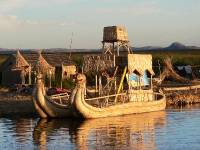Profile
Blog
Photos
Videos
To get to the research station, three of the four other students on the research team and I took a 5 hour boat ride up the Madre de Dios River.I finally felt like I was in the rainforest - on the way down river there were tons of birds, and a few tiny villages, along with many gold mining set-ups.The area is rich in gold, and Peruvians mine it by pumping up sediment from the river banks and moving it along mats to separate the lighter sediments from the gold.Mercury is then used because it binds the gold.The mercury goes straight into the river - we can't eat any fish here because of it, and supposedly it has started causing higher rates of birth defects in the area.When the gold is taken to Puerto Maldonado, the mercury has to be burned off the gold and into the air before the miners can take it to the bank to be weighed.The price of gold right now is about $30 per gram (to put that in perspective, a motorbike, the main form of transportation in Puerto, is only about 130 soles or $48, so $30 for a single gram of gold is a lot!)Despite the unattractive gold mining, the banks of the river are still beautiful with their enormous trees and dense jungle on either side.I also saw this 4 or 5 year old boy from one of the villages standing on the river bank, completely surrounded by a huge cloud of yellow butterflies.I couldn't get my camera really in time for a picture but it was amazing to see.
I was very excited to finally get to CICRA , especially after going up-river and getting a sense of just how remote this place is.If it weren't for the boats parked on the bank in front of the research camp I don't think you'd even notice it from the river.CICRA welcomed me with its MASSIVE staircase, which I got to haul my 3 months worth of luggage to the top of.The camp is such a peaceful place, without the sounds of traffic or crowds of people, and even the boats are too far away to hear.There are also some of the most gorgeous and bizarre trees - one of them just looks like a tall pole with huge needles poking out of every inch of its trunk.The researcher cabins are tucked back in the forest a little bit away from the main camp, and as I was taking my stuff to the cabin I saw my first monkeys!A group of 3 adult titi monkeys and 1 juvenile.They're brown with fluffy tails, and small, but slightly bigger than the tamarins.I hadn't expected to see them so soon!:)
Yesterday morning I saw my first tamarins!They hang right around camp, and I got to watch a group of saddlebacks and a group of the emperor tamarins at the same time.They make very high pitched vocalizations that sounds like birds, though I haven't gotten the hang of telling apart the saddleback calls from the emperors yet.Later in the morning, on my first trek on part of the extensive trail system around the camp, I also saw a lone saddleback female who doesn't stay with a family group for some reason, as well as some more titis.I also spotted a beautiful yellow and grey bird that was later identified as a bat falcon.I even got my first look at a bullet ant, which is this horrible 1-inch long black ant that gets its name from the pain of its bite, which supposedly feels like getting shot.Three of the Primates Peru team have been bitten in their time here, and I'm really reaaaaaally hoping I can avoid this!!Wish me luck.Several others here are dealing with botflies, which are pretty disgusting though I'd much rather deal with that than the bullet ant.I don't think I'll be here much longer getting away with only a sunburn from the boat ride.
Other sightings:2 8-inch lizards, a frog the size of a tamarin, a bat that almost flew into my face, 7 macaws, a parrot, deer prints, and big cat prints (jaguar, mountain lion, or ocelot?)
Animals still to be seen:white lipped peccary, saki monkeys, capuchins, squirrel monkeys, capybara, caiman, boa constrictor (apparently one lives in one of the cabins) and . . .jaguar :)
Still getting used to:wearing boots all the time, freezing cold showers (there's no hot water here)
- comments




